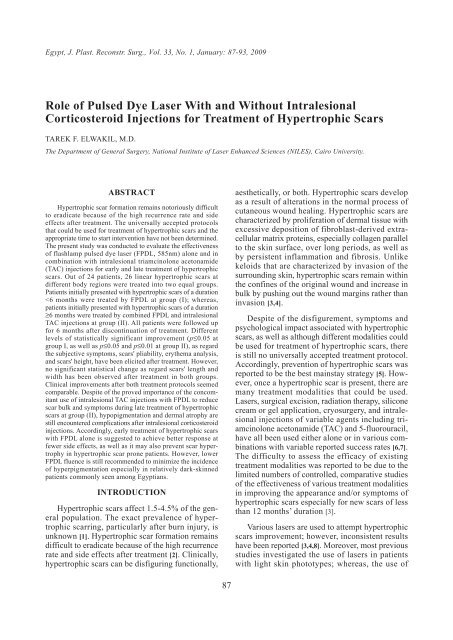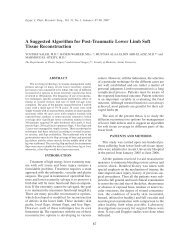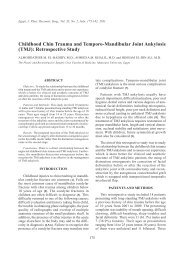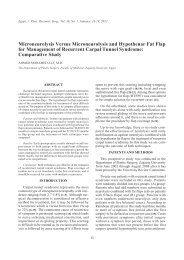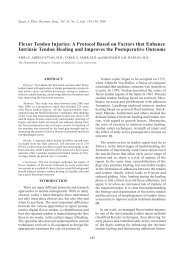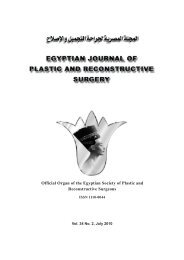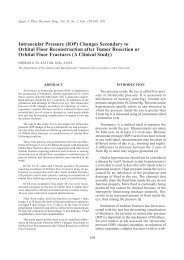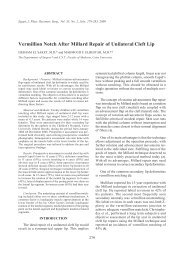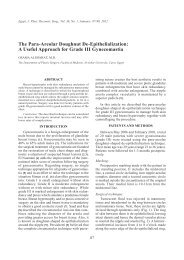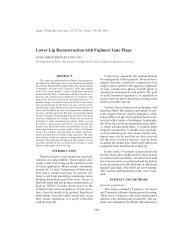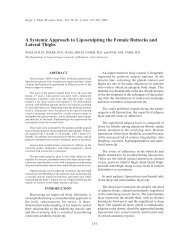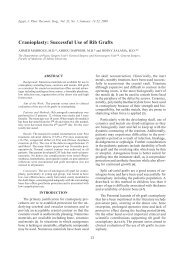Role of Pulsed Dye Laser With and Without Intralesional ... - ESPRS
Role of Pulsed Dye Laser With and Without Intralesional ... - ESPRS
Role of Pulsed Dye Laser With and Without Intralesional ... - ESPRS
You also want an ePaper? Increase the reach of your titles
YUMPU automatically turns print PDFs into web optimized ePapers that Google loves.
Egypt, J. Plast. Reconstr. Surg., Vol. 33, No. 1, January: 87-93, 2009<br />
<strong>Role</strong> <strong>of</strong> <strong>Pulsed</strong> <strong>Dye</strong> <strong>Laser</strong> <strong>With</strong> <strong>and</strong> <strong>With</strong>out <strong>Intralesional</strong><br />
Corticosteroid Injections for Treatment <strong>of</strong> Hypertrophic Scars<br />
TAREK F. ELWAKIL, M.D.<br />
The Department <strong>of</strong> General Surgery, National Institute <strong>of</strong> <strong>Laser</strong> Enhanced Sciences (NILES), Cairo University.<br />
ABSTRACT<br />
Hypertrophic scar formation remains notoriously difficult<br />
to eradicate because <strong>of</strong> the high recurrence rate <strong>and</strong> side<br />
effects after treatment. The universally accepted protocols<br />
that could be used for treatment <strong>of</strong> hypertrophic scars <strong>and</strong> the<br />
appropriate time to start intervention have not been determined.<br />
The present study was conducted to evaluate the effectiveness<br />
<strong>of</strong> flashlamp pulsed dye laser (FPDL, 585nm) alone <strong>and</strong> in<br />
combination with intralesional triamcinolone acetonamide<br />
(TAC) injections for early <strong>and</strong> late treatment <strong>of</strong> hypertrophic<br />
scars. Out <strong>of</strong> 24 patients, 26 linear hypertrophic scars at<br />
different body regions were treated into two equal groups.<br />
Patients initially presented with hypertrophic scars <strong>of</strong> a duration<br />
88 Vol. 33, No. 1 / <strong>Role</strong> <strong>of</strong> <strong>Pulsed</strong> <strong>Dye</strong> <strong>Laser</strong> <strong>With</strong> & <strong>With</strong>out <strong>Intralesional</strong> Corticosteroid<br />
lasers for treatment <strong>of</strong> hypertrophic scars in darkskinned<br />
patients is not well established [9-11].<br />
Furthermore, the appropriate time to start treatment<br />
<strong>of</strong> hypertrophic scars has not been determined<br />
[6,12,13].<br />
Accordingly, the present study was conducted<br />
to evaluate the effectiveness <strong>of</strong> flashlamp pulsed<br />
dye laser (FPDL, 585nm) alone <strong>and</strong> in combination<br />
with intralesional TAC injections for early <strong>and</strong> late<br />
treatment <strong>of</strong> hypertrophic scars.<br />
PATIENTS AND METHODS<br />
Twenty-four patients, <strong>of</strong> both sexes <strong>and</strong> different<br />
skin phototypes, with twenty-six linear hypertrophic<br />
scars at different body regions were included in<br />
the present study. All the enrolled scars did not<br />
heal to the patients’ satisfaction. Keloid scars were<br />
excluded from the present study. Moreover, hypertrophic<br />
scars treated within the preceding 2 months<br />
were excluded from the present study. According<br />
to hypertrophic scars’ durations at initial presentations,<br />
patients were classified into two equal groups.<br />
Patients initially presented with hypertrophic scars<br />
<strong>of</strong> a duration
Egypt, J. Plast. Reconstr. Surg., January 2009 89<br />
Regarding the results <strong>of</strong> treatment, Table (2)<br />
summarizes the evaluating parameters for each<br />
group before treatment, as well as 6 months’ period<br />
<strong>of</strong> follow up after treatment including; the improvement<br />
<strong>of</strong> the subjective symptoms, scars’ pliability<br />
scale, erythema analysis <strong>and</strong> scars’ dimensions.<br />
The percentages <strong>of</strong> erythema clearance after treatment<br />
were found to be 44.72%±10.36% <strong>and</strong><br />
62%±12.53% at statistical significances <strong>of</strong> p≤0.05<br />
<strong>and</strong> p≤0.01 for groups (I <strong>and</strong> II), respectively.<br />
Hyperpigmentation was the only complication after<br />
early treatment <strong>of</strong> scars at group (I). It was elicited<br />
in only 2 scars (15.38%). However, after late<br />
treatment <strong>of</strong> scars at group (II); hyperpigmentation<br />
was elicited in 5 scars (38.46%) <strong>and</strong> hypopigmentation<br />
<strong>and</strong> dermal atrophy were observed in 2 scars<br />
(15.38%), for each.<br />
Figs. (1,2) (A,B) show patients at groups (I <strong>and</strong><br />
II, respectively) with hypertrophic scars before<br />
treatment <strong>and</strong> 6 months’ period <strong>of</strong> follow-up after<br />
treatment, respectively.<br />
Fig. (1): Right lateral view for a patient at group (I) with hypertrophic scar treated by FPDL; (A) before treatment <strong>and</strong> (B) 6<br />
months’ period <strong>of</strong> follow-up after treatment.<br />
Fig. (2): Left lateral view for a patient at group (II) with hypertrophic scars treated by combined<br />
FPDL <strong>and</strong> intralesional TAC injections; (A) before treatment <strong>and</strong> (B) 6 months’ period<br />
<strong>of</strong> follow-up after treatment.
90 Vol. 33, No. 1 / <strong>Role</strong> <strong>of</strong> <strong>Pulsed</strong> <strong>Dye</strong> <strong>Laser</strong> <strong>With</strong> & <strong>With</strong>out <strong>Intralesional</strong> Corticosteroid<br />
Table (1): Patients’ <strong>and</strong> scars’ data before starting treatment. Data are presented as numbers (%), mean values ± st<strong>and</strong>ard<br />
deviations <strong>and</strong> ranges.<br />
Clinical data<br />
Sex:<br />
Male<br />
Female<br />
Age (Yrs)<br />
Skin phototype:<br />
II<br />
III<br />
IV<br />
V<br />
Number <strong>of</strong> hypertrophic scars<br />
Locations:<br />
Head <strong>and</strong> neck<br />
Trunk<br />
Extremities<br />
Scar duration (months)<br />
Occurrence:<br />
De novo<br />
Recurrent<br />
Previous treatment:<br />
Surgical excision<br />
<strong>Intralesional</strong> corticosteroid injection<br />
Silicone gel sheeting<br />
Table (2): Evaluating parameters for each group before treatment <strong>and</strong> 6 months’ period <strong>of</strong> follow-up after treatment. Data are<br />
presented as numbers (%), mean values ± st<strong>and</strong>ard deviations <strong>and</strong> ranges. Note: N.S. means not statistically significant.<br />
Evaluating parameters<br />
Subjective symptoms:<br />
1 (absent)<br />
2 (mild)<br />
3 (moderate)<br />
4 (severe)<br />
Scars’ pliability scale:<br />
1<br />
2<br />
3<br />
4<br />
5<br />
Erythema analysis<br />
Scars’ dimensions:<br />
Length (mm)<br />
Width (mm)<br />
Height (mm)<br />
Before<br />
Treatment<br />
–<br />
3 (23.08%)<br />
10 (76.92%)<br />
–<br />
–<br />
2 (15.38%)<br />
8 (61.54%)<br />
3 (23.08%)<br />
–<br />
204.82±43.67<br />
(238-153)<br />
52±30.07<br />
(20-100)<br />
8.62±3.55<br />
(5-12)<br />
3.77±2.17<br />
(3-5)<br />
After<br />
Treatment<br />
–<br />
9 (69.23%)<br />
4 (30.77%)<br />
–<br />
1 (7.69%)<br />
5 (38.46%)<br />
7 (53.85%)<br />
–<br />
–<br />
163.5±24.8<br />
(181-127)<br />
51.22±27.42<br />
(20-100)<br />
9.15±2.39<br />
(5-14)<br />
1.06±0.24<br />
(0-2)<br />
All patients<br />
(n=24)<br />
14 (58.33%)<br />
10 (41.67%)<br />
22.50±15.89<br />
(4-42)<br />
2 (8.33%)<br />
9 (37.5%)<br />
10 (41.67%)<br />
3 (12.5%)<br />
26<br />
18 (69.23%)<br />
3 (11.54%)<br />
5 (19.23%)<br />
9.58±7.59<br />
(2-18)<br />
14 (53.85%)<br />
12 (46.15%)<br />
8 (30.77%)<br />
4 (15.39%)<br />
7 (26.92%)<br />
Group (I)<br />
(n=13 Hypertrophic scars)<br />
p<br />
Value<br />
≤0.05<br />
≤0.05<br />
≤0.05<br />
N.S.<br />
N.S.<br />
≤0.05<br />
Group (I)<br />
(n=12 pts)<br />
8 (66.67%)<br />
4 (33.33%)<br />
21.25±10.79<br />
(4-38)<br />
2 (16.67%)<br />
6 (50%)<br />
4 (33.33%)<br />
–<br />
13<br />
12 (92.31%)<br />
–<br />
1 (7.69%)<br />
3.83±1.07<br />
(2-5)<br />
6 (46.15%)<br />
7 (53.85%)<br />
5 (38.46%)<br />
1 (7.69%)<br />
3 (23.08%)<br />
Before<br />
Treatment<br />
–<br />
–<br />
6 (46.15%)<br />
7 (53.85%)<br />
–<br />
–<br />
4 (30.77%)<br />
9 (69.23%)<br />
–<br />
212.56±53.17<br />
(244-165)<br />
52.69±30.24<br />
(20-120)<br />
12.46±4.14<br />
(5-16)<br />
5.46±2.13<br />
(5-7)<br />
Group (II)<br />
(n=13 Hypertrophic scars)<br />
After<br />
Treatment<br />
–<br />
5 (38.46%)<br />
8 (61.54%)<br />
–<br />
2 (15.38%)<br />
4 (30.77%)<br />
7 (53.85%)<br />
–<br />
–<br />
132.7±16.2<br />
(161-110)<br />
51.66±31.79<br />
(20-120)<br />
13.36±3.57<br />
(5-18)<br />
1.48±1.06<br />
(0-3)<br />
Group (II)<br />
(n=12 pts)<br />
6 (50%)<br />
6 (50%)<br />
29.75±12.23<br />
(14-42)<br />
–<br />
3 (25%)<br />
6 (50%)<br />
3 (25%)<br />
13<br />
6 (46.15%)<br />
3 (23.08%)<br />
4 (30.77%)<br />
12.33±5.57<br />
(6-18)<br />
8 (61.54%)<br />
5 (38.46%)<br />
3 (23.08%)<br />
3 (23.08%)<br />
4 (30.77%)<br />
p<br />
Value<br />
≤0.05<br />
≤0.01<br />
≤0.01<br />
N.S.<br />
N.S.<br />
≤0.01
Egypt, J. Plast. Reconstr. Surg., January 2009 91<br />
DISCUSSION<br />
Although the basis <strong>of</strong> hypertrophic scar formation<br />
has not been fully delineated, an imbalance<br />
between matrix degradation <strong>and</strong> collagen biosynthesis<br />
resulting into excess collagen accumulation<br />
in the wound has been postulated. Normally, fibroblasts<br />
construct new extracellular matrix, initiate<br />
collagen synthesis, <strong>and</strong> provide wound edge tension<br />
along contractile proteins; actin <strong>and</strong> desmin. On<br />
the other h<strong>and</strong>, hypertrophic scar-derived fibroblasts<br />
produce increased amount <strong>of</strong> collagen per cell<br />
compared with normal fibroblasts [3,4]. Accordingly,<br />
the suppression <strong>of</strong> overwhelming <strong>and</strong> uncontrolled<br />
fibroblast activity in hypertrophic scars may be an<br />
essential approach during treatment <strong>of</strong> this abnormal<br />
wound healing. However, hypertrophic scar<br />
formation remains a difficult problem to eradicate.<br />
This is not only due to the high recurrence rate;<br />
where 46.15% <strong>of</strong> the scars in the present study<br />
were recurrent, but due to the incidence <strong>of</strong> side<br />
effects associated with treatment as well [2].<br />
The effectiveness <strong>of</strong> FPDL treatment <strong>of</strong> hypertrophic<br />
scars is hypothesized to be mediated to the<br />
selective photothermolytic effect <strong>of</strong> FPDL on scars’<br />
microvasculature with consequent wound ischaemia<br />
[15]. Moreover, the improvement in skin texture <strong>of</strong><br />
scars treated with FPDL was found to be an interesting<br />
observation that adds a significant favorable<br />
outcome. This textural improvement is suggested<br />
to be due to collagen remodeling, the same concept<br />
for the improvement seen with FPDL treatment <strong>of</strong><br />
photoaged skin [16]. Despite <strong>of</strong> the effectiveness<br />
<strong>of</strong> FPDL treatment <strong>of</strong> hypertrophic scars, three<br />
debatable issues should be concerned namely; the<br />
appropriate laser fluence to be used, the frequency<br />
<strong>of</strong> the treatment sessions <strong>and</strong> the appropriate time<br />
to start treatment.<br />
First; regarding the appropriate fluence to be<br />
used, the fluence-dependent inhibition <strong>of</strong> hypertrophic<br />
scar formation after FPDL treatment was<br />
reported to be proportional to the used fluence<br />
[4,15]. This was clearly elicited in the present study<br />
where a relatively lower fluence (5.28±0.22J/cm 2)<br />
was needed for early treatment <strong>of</strong> less bulky scars<br />
at group (I) compared with the higher fluence<br />
(6.55±0.37J/cm 2) used for late treatment <strong>of</strong> more<br />
bulky scars at group (II). On the contrary, others<br />
observed no significant difference in the treatment<br />
results with the used fluences [17,18]; however, a<br />
concept toward better responses <strong>and</strong> fewer side<br />
effects with lower FPDL fluence was observed [3].<br />
Second; regarding the frequency <strong>of</strong> treatment<br />
sessions, Wittenberg et al. [4], reported that there<br />
was no clinical improvement with 4 FPDL (585nm)<br />
sessions. In contrast, Goldman <strong>and</strong> Fitzpatrick [17]<br />
reported the reverse. This positive result is confirmed<br />
in the present study, where flattening <strong>of</strong> the<br />
scars at both groups was observed about as early<br />
as the 16 th week after FPDL treatment (4 weeks<br />
after the 4 th treatment session). Moreover, higher<br />
rate <strong>of</strong> scar flattening was elicited after more than<br />
two FPDL treatment sessions. Accordingly, multiple<br />
<strong>and</strong> sequential FPDL treatment sessions are essential<br />
to achieve better clinical outcome. However,<br />
it was still observed that late treatment <strong>of</strong> bulky<br />
scars at group (II) needed more frequent FPDL<br />
sessions (5.15±0.8) compared with the less frequent<br />
sessions (4.46±1.13) needed for early treatment <strong>of</strong><br />
less bulky scars at group (I).<br />
Third; regarding the appropriate time to start<br />
treatment <strong>and</strong> because <strong>of</strong> the natural history <strong>of</strong> the<br />
proposed spontaneous improvement <strong>of</strong> hypertrophic<br />
scars during the first 6-12 months after injury, the<br />
evaluation <strong>of</strong> early treatment <strong>of</strong> hypertrophic scars<br />
may be difficult [3]. However, hypertrophic scars<br />
younger than 12 months were still included in the<br />
present study for few reasons. First, it was hypothesized<br />
that if any hypertrophic scars were to improve<br />
with FPDL treatment, it would be the younger,<br />
erythematous scars. Second, it was hypothesized<br />
that early FPDL treatment would prevent hypertrophic<br />
scars from getting worse. Finally, many<br />
studies have reported the use <strong>of</strong> FPDL for early<br />
treatment <strong>of</strong> hypertrophic scars younger than 6<br />
months duration starting even on the day <strong>of</strong> suture<br />
removal [6,9,12,13], as well as for late treatment <strong>of</strong><br />
hypertrophic scars <strong>of</strong> more than 6 months’ duration<br />
[3].<br />
All intralesional formulas have shown comparable<br />
results in hypertrophic scar flattening. They<br />
have been suggested to have higher effectiveness<br />
than laser treatment [3]. The role <strong>of</strong> intralesional<br />
corticosteroid injections for treatment <strong>of</strong> hypertrophic<br />
scars has been well-established. The suppression<br />
mechanisms <strong>of</strong> intralesional corticosteroid<br />
injection on wound healing include; first, the interruption<br />
<strong>of</strong> the inflammatory cell migration <strong>and</strong><br />
phagocytosis. Second, it induces vasoconstriction<br />
resulting into deprivation <strong>of</strong> oxygen <strong>and</strong> nutrients<br />
in the wound. Third, it has an anti-mitotic activity<br />
on fibroblasts <strong>and</strong> keratinocytes [2,3]. Collectively,<br />
intralesional corticosteroid injection was reported<br />
to produce objective improvements in hypertrophic<br />
scar volume <strong>and</strong> symptoms especially for those<br />
scars <strong>of</strong> more than 6 months’ duration [1-3]. Accordingly,<br />
it was considered in the present study<br />
for late treatment <strong>of</strong> more bulky scars at group (II)<br />
rather than less bulky scars at group (I).
92 Vol. 33, No. 1 / <strong>Role</strong> <strong>of</strong> <strong>Pulsed</strong> <strong>Dye</strong> <strong>Laser</strong> <strong>With</strong> & <strong>With</strong>out <strong>Intralesional</strong> Corticosteroid<br />
Triamcinolone acetonamide (TAC) is the most<br />
commonly used corticosteroid for treatment <strong>of</strong><br />
hypertrophic scars. Although intralesional TAC<br />
injection has shown clinical efficacy, the results<br />
have been uncertain <strong>and</strong> frequently associated with<br />
many side effects including; pigmentary changes,<br />
<strong>and</strong> dermal atrophy [19-21]. Theoretically, the combination<br />
therapy is supposed to be <strong>of</strong> value in order<br />
to achieve better results <strong>and</strong> to minimize the associated<br />
complications. However, there is a debate<br />
about the effectiveness <strong>of</strong> the combined treatment<br />
<strong>of</strong> FPDL <strong>and</strong> intralesional TAC injections [2,3].<br />
Recently, others reported the effectiveness <strong>of</strong> this<br />
combination [19,21]. Similarly, different levels <strong>of</strong><br />
statistically significant clinical improvements<br />
(p≤0.05 <strong>and</strong> p≤0.01) have been elicited after combined<br />
FPDL <strong>and</strong> intralesional TAC injections for<br />
late treatment <strong>of</strong> scars at group (II). However,<br />
despite <strong>of</strong> the proved importance <strong>of</strong> the concomitant<br />
use <strong>of</strong> intralesional TAC injections with FPDL to<br />
reduce scar bulk <strong>and</strong> symptoms during late treatment<br />
<strong>of</strong> hypertrophic scars at group (II), hypopigmentation<br />
<strong>and</strong> dermal atrophy are still encountered<br />
complications after intralesional corticosteroid<br />
injections.<br />
Finally, it was frequently reported that high<br />
melanin in dark-skinned patients; as it is commonly<br />
seen among Egyptians, is a competitive chromophore<br />
to haemoglobin during FPDL treatment<br />
[9-11]. Accordingly, more frequent sessions <strong>of</strong> FP-<br />
DL at higher fluence were found to be needed for<br />
effective treatment especially for late treatment <strong>of</strong><br />
more bulky scars at group (II) rather than early<br />
treatment <strong>of</strong> less bulky scars at group (I). However,<br />
this could explain; meanwhile, the inevitable higher<br />
incidence <strong>of</strong> hyperpigmentation (38.46%) after<br />
late treatment <strong>of</strong> scars at group (II) compared with<br />
the lower incidence <strong>of</strong> hyperpigmentation (15.38%)<br />
after early treatment <strong>of</strong> scars at group (I).<br />
Conclusion:<br />
FPDL alone <strong>and</strong> its combination with intralesional<br />
TAC injections are effective modalities that<br />
could be used for early <strong>and</strong> late treatment <strong>of</strong><br />
hypertrophic scars, respectively. Clinical improvements<br />
after both treatment protocols seemed comparable.<br />
Different levels <strong>of</strong> statistically significant<br />
improvements (p≤0.05 at group I, as well as<br />
p≤0.05 <strong>and</strong> p≤0.01 at group II), regarding the<br />
subjective symptoms, scars’ pliability, erythema<br />
analysis <strong>and</strong> scars’ height, have been elicited after<br />
treatment. However, no significant statistical<br />
change was observed as regard scars’ length <strong>and</strong><br />
width after treatment in both groups. Despite <strong>of</strong><br />
the proved importance <strong>of</strong> the concomitant use <strong>of</strong><br />
intralesional TAC injections with FPDL to reduce<br />
scar bulk <strong>and</strong> symptoms during late treatment <strong>of</strong><br />
hypertrophic scars at group (II), hypopigmentation<br />
<strong>and</strong> dermal atrophy are still encountered complications.<br />
Accordingly, early treatment <strong>of</strong> hypertrophic<br />
scars with FPDL alone is suggested to<br />
achieve better response at fewer side effects, as<br />
well as it may also prevent scar hypertrophy in<br />
hypertrophic scar prone patients. However, lower<br />
FPDL fluence is still recommended to minimize<br />
the incidence <strong>of</strong> hyperpigmentation especially in<br />
relatively dark-skinned patients commonly seen<br />
among Egyptians.<br />
Acknowledgement:<br />
The author expresses his deep appreciation to<br />
late Pr<strong>of</strong>. Dr. Mohamed Abdel-Hamid Eid, Pr<strong>of</strong>essor<br />
<strong>of</strong> Spectroscopy, Department <strong>of</strong> Spectroscopy,<br />
National Research Center (NRC), who did a great<br />
effort during formulation <strong>of</strong> the equation used for<br />
erythema evaluation <strong>and</strong> calculation <strong>of</strong> erythema<br />
clearance.<br />
REFERENCES<br />
1- Atiyeh B.S.: Nonsurgical management <strong>of</strong> hypertrophic<br />
scars: Evidence-based therapies, st<strong>and</strong>ard practices <strong>and</strong><br />
emergency methods. Aesth. Plast. Surg., 31: 468-492,<br />
2007.<br />
2- Alster T.S.: <strong>Laser</strong> scar revision: Comparison study <strong>of</strong><br />
585-nm pulsed dye laser with <strong>and</strong> without intralesional<br />
corticosteroids. Dermatol. Surg., 29 (1): 25-29, 2003.<br />
3- Manuskiatti W. <strong>and</strong> Fitzpatrick R.E.: Treatment response<br />
<strong>of</strong> keloidal <strong>and</strong> hypertrophic sternotomy scars: Comparison<br />
among intralesional corticosteroid, 5-fluorouracil <strong>and</strong><br />
585-nm flashlamp-pumped pulsed-dye laser treatments.<br />
Arch. Dermatol., 138 (9): 1149-1155, 2002.<br />
4- Wittenberg G.P., Fabian B.G., Bogomilsky J.L., Schultz<br />
L.R., Rudner E.J., Chaffins M.L., Saed G.M., Burns R.L.<br />
<strong>and</strong> Fivenson D.P.: Prospective, single-blind, r<strong>and</strong>omized,<br />
controlled study to assess the efficacy <strong>of</strong> the 585-nm<br />
flashlamp-pumped pulsed-dye laser <strong>and</strong> silicone gel<br />
sheeting in hypertrophic scar treatment. Arch. Dermatol.,<br />
135 (9): 1049-1055, 1999.<br />
5- Alster T.S. <strong>and</strong> Tanzi E.L.: Hypertrophic scars <strong>and</strong> keloids:<br />
Etiology <strong>and</strong> management. Am. J. Clin. Dermatol., 4 (4):<br />
235-243, 2003.<br />
6- Alam M., Pon K., Van Laborde S., Kaminer M.S., Arndt<br />
K.A. <strong>and</strong> Dover J.S.: Clinical effect <strong>of</strong> a single pulsed<br />
dye laser treatment <strong>of</strong> fresh surgical scars: R<strong>and</strong>omized<br />
controlled trial. Dermatol. Surg., 32 (1): 21-25, 2006.<br />
7- Kono T., Erçöçen A.R., Nakazawa H. <strong>and</strong> Nozaki M.:<br />
Treatment <strong>of</strong> hypertrophic scars using a long-pulsed dye<br />
laser with cryogen-spray cooling. Ann. Plast. Surg., 54<br />
(5): 487-493, 2005.<br />
8- Bouzari N., Davis S.C. <strong>and</strong> Nouri K.: <strong>Laser</strong> treatment <strong>of</strong><br />
keloids <strong>and</strong> hypertrophic scars. Int. J. Dermatol., 46 (1):<br />
80-88, 2007.
Egypt, J. Plast. Reconstr. Surg., January 2009 93<br />
9- Chan H.H., Wong D.S., Ho W.S., Lam L.K. <strong>and</strong> Wei W.:<br />
The use <strong>of</strong> pulsed dye laser for the prevention <strong>and</strong> treatment<br />
<strong>of</strong> hypertrophic scars in Chinese persons. Dermatol.<br />
Surg., 30 (7): 987-994, 2004.<br />
10- Kono T., Erçöçen A.R., Nakazawa H., Honda T., Hayashi<br />
N. <strong>and</strong> Nozaki M.: The flashlamp-pumped pulsed dye<br />
laser (585nm) treatment <strong>of</strong> hypertrophic scars in Asians.<br />
Ann. Plast. Surg., 51 (4): 366-371, 2003.<br />
11- Manuskiatti W., Wanitphakdeedecha R. <strong>and</strong> Fitzpatrick<br />
R.E.: Effect <strong>of</strong> pulse width <strong>of</strong> a 595-nm flashlamp-pumped<br />
pulsed dye laser on the treatment response <strong>of</strong> keloidal<br />
<strong>and</strong> hypertrophic sternotomy scars. Dermatol. Surg., 33<br />
(2): 152-161, 2007.<br />
12- Conologue T.D. <strong>and</strong> Norwood C.: Treatment <strong>of</strong> surgical<br />
scars with the cryogen-cooled 595-nm pulsed dye laser<br />
starting on the day <strong>of</strong> suture removal. Dermatol. Surg.,<br />
32 (1): 13-20, 2006.<br />
13- Nouri K., Jimenez G.P., Harrison-Balestra C. <strong>and</strong> Elgart<br />
G.W.: 585-nm pulsed dye laser in the treatment <strong>of</strong> surgical<br />
scars starting on the suture removal day. Dermatol. Surg.,<br />
29 (1): 65-73, 2003.<br />
14- Sullivan T., Smith J., Kermode J., Mclver E. <strong>and</strong> Courtemanche<br />
D.J.: Rating the burn scar. J. Burn Care Rehabil.,<br />
11: 256-260, 1990.<br />
15- Reiken S.R., Wolfort S.F., Berthiaume F., Compton C.,<br />
Tompkins R.G. <strong>and</strong> Yarmush M.L.: Control <strong>of</strong> hypertrophic<br />
scar growth using selective photothermolysis. <strong>Laser</strong>s<br />
Surg. Med., 21: 7-12, 1997.<br />
16- Bjerring P., Clement M., Heickendorff L., Egevist H. <strong>and</strong><br />
Kiernan M.: Selective non-ablative wrinkle reduction by<br />
laser. J. Cutan. <strong>Laser</strong> Ther., 2: 9-15, 2000.<br />
17- Goldman M.P. <strong>and</strong> Fitzpatrick R.E.: <strong>Laser</strong> treatment <strong>of</strong><br />
scars. Dermatol. Surg., 21: 685-687, 1995.<br />
18- Manuskiatti W., Fitzpatrick R.E. <strong>and</strong> Goldman M.P.:<br />
Energy density <strong>and</strong> numbers <strong>of</strong> treatment affect response<br />
<strong>of</strong> keloidal <strong>and</strong> hypertrophic sternotomy scars to the 585nm<br />
flashlamp-pumped pulsed-dye laser. J. Am. Acad.<br />
Dermatol., 45 (4): 557-565, 2001.<br />
19- Asilian A., Darougheh A. <strong>and</strong> Shariati F.: New combination<br />
<strong>of</strong> triamcinolone, 5-Fluorouracil <strong>and</strong> pulsed-dye laser for<br />
treatment <strong>of</strong> keloid <strong>and</strong> hypertrophic scars. Dermatol.<br />
Surg., 32 (7): 907-915, 2006.<br />
20- Beuth J., Hunzelmann N., Van Leendert R., Basten R.,<br />
Noehle M. <strong>and</strong> Schneider B.: Safety <strong>and</strong> efficacy <strong>of</strong> local<br />
administration <strong>of</strong> contractubex to hypertrophic scars in<br />
comparison to corticosteroid treatment. Results <strong>of</strong> a<br />
multicenter, comparative epidemiological cohort study<br />
in Germany. In Vivo, 20 (2): 277-283, 2006.<br />
21- Arndt K.A., Dover J.S. <strong>and</strong> Alam M.: Scar revision.<br />
Philadelphia: Elsevier Saunders, 1 st ed., 2006.


